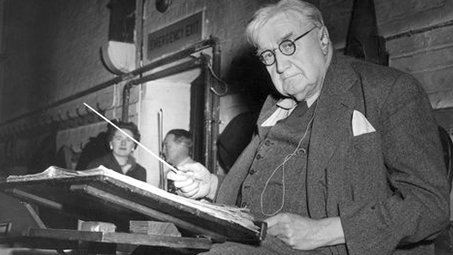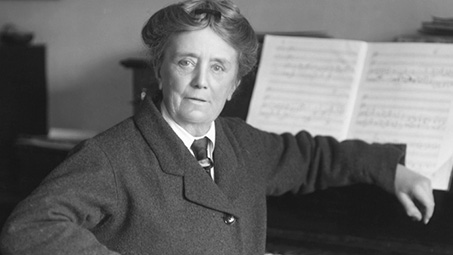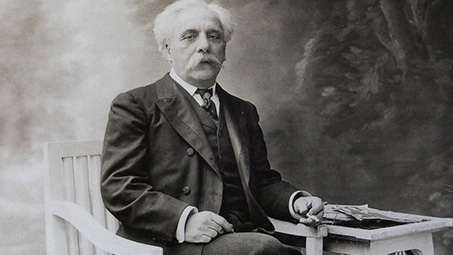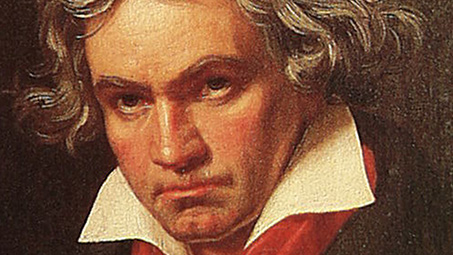Composers and hearing loss
Whether we are composers, performers, or audiences, our senses influence the way we experience music both live, and via various media from TV broadcasts and films to interactive Zoom gatherings. In our final blog post ahead of the premiere of Platform4’s Invisible Music on 15 July, Concert Hall Manager Kevin Appleby looks at four composers, each of whom experienced loss of hearing, and responded to its impact in different ways.
Ralph Vaughan Williams (1872-1958)
One of the most well-known images of British composer Ralph Vaughan Williams is a painting by Sir Gerald Kelly, begun shortly before the composer’s death in 1958, and donated to the National Portrait Gallery by his widow Ursula in 1970. The painting itself depicts Vaughan Williams as both active composer and conductor, seated as he is with a musical score in front of him, and a baton in hand. What one’s eye is also drawn to though is the hearing aid which he wears in his left ear. Increasingly hard of hearing in his later years due to exposure to gunfire while serving in World War I, the composer possessed, according to biographer James Day, ‘…a veritable battery of hearing aids, the largest of which he referred to as his ‘coffee pot’. His advancing deafness somewhat restricted his enjoyment of music for large forces, but to the end of his days he continued to attend performances by composers – such as Holst – of whose music he was particularly fond’ [The Master Musicians: Vaughan Williams, Dent, 1961 p70].
Find the portrait of Vaughan Williams here
Find out more about Ralph Vaughan Williams
Like Vaughan Williams, Dame Ethel Smyth served in World War I, and lived in to her 80s. Unlike her fellow English composer, her hearing loss, which began around 1913 when she was in her fifties, led to a significant, and ultimately successful change of direction.
Perhaps best known for her 1906 opera The Wreckers, Smyth described the onset of deafness as a ‘death grapple’. Initially hearing ringing in her ears, she managed to complete only four more major works before deafness brought her composing career to an end. These include The Prison, a choral symphony premiered at the Usher Hall in Edinburgh in 1931, and conducted, at the age of 72, by the composer, in spite of the fact that she was almost deaf.
Whilst her composing career waned, she reinvented herself as a writer. Between 1919 and 1940 she produced 10 books of memoirs, travel diaries, and biographical portraits. The books gave her new purpose, an income, new friends (including Virginia Woolf, whom she met in 1930), and enthusiastic new audiences. At the end of her life she was as well-known as a writer if not more so than she was as a composer.
Find out more about Dame Ethel Smyth
French composer Gabriel Fauré is most remembered for his Requiem (1893), songs, and chamber music, and yet was also a renowned organist, teacher and academic. Having succeeded Jules Massenet as teacher of composition at the Paris Conservatoire in 1896, he became director in 1905. His retirement from that position, in 1920, came largely due to his increasing deafness, which had first become apparent some 20 years earlier.
The onset of deafness saw his ability to hear certain qualities in music diminished. Lauren Cornwell writes:
‘He reported hearing double sounds, high notes became sharp, and low notes became flat. The distortions he heard in sounds due to his deafness are suggested as a possible reason for why his Late Period compositions are all composed within a mid-range. In order to continue composing he had to avoid writing in areas of the voice that were too painful to hear.’ [“Exploration of Fauré’s “Poème d’un jour ” Through Lecture and Recital”, Bowling Green State University 2015]
Despite these limitations, Fauré, unlike Ethel Smyth, continued composing until his death in 1924, with this later period (from 1920) seeing the production of his sole works for piano trio (Op 120 in 1923), and string quartet (Op 121 in 1924).
Hear Fauré’s String Quartet, Op 121, performed by the Castilian Quartet at London’s Wigmore Hall
Ludwig Van Beethoven (1770-1827)
For our final composer we turn to Beethoven, arguably the most famous composer to have experienced hearing loss. For an insight into his condition, and how it affected his work, I spoke to Professor William Drabkin, Emeritus Professor of Music at the University of Southampton, and a Beethoven expert:
There hasn’t, to my knowledge, been much in the way of new research on the condition as it affected Beethoven in his lifetime: we know that he began noticing his deafness in 1796 when he was in his mid-20s, and he started writing about it (in letters to friends) a couple of years later, at the age of 27.
His hearing probably deteriorated in stages, rather than making a gradual decline over 30 years; the only incident recorded from the middle of his life (age 38) was when Napoleon’s troops invaded Vienna in 1809 and Beethoven is reported to have covered his ears with pillows because the sound of artillery was so painful.
He consulted physicians about it (largely to no avail) and had ‘ear trumpets’ made (though we don’t know that he used them much).
From 1818 he asked his visitors to write down what they wanted to say to him in notebooks, and he would reply verbally. These ‘conversation books’ as they are called, have all been published and provide an almost day-to-day account of his life during the last decade of his life; but they don’t really say anything about his actual condition of being deaf.
Nor, I have to say, do any of his compositions! There’s no attempt to convey the sense of deafness anywhere in musical terms. There’s a noisy passage in the Scherzo of the last string quartet, but it’s not a ringing sound (tinnitus). For this, we have the famous example of the last few bars of Smetana’s String Quartet in E minor, From My Life, in which the first violin plays a high harmonic on the E-string. But even that is an almost incidental event, more a ‘reality check’ signal that enables Smetana to put the dance music of the finale in check and allow the work to finish on a quieter, more reflective ending.
Of broader interest is that, towards the end of the Industrial Era, by which I mean the mid to late 19th century, some musicians were actually envious of Beethoven because they thought his deafness spared him having to live in a horribly noisy environment. There’s an article by K. M. Knittel from 1998, on that very subject, entitled ‘Wagner, Deafness, and the Reception of Beethoven’s Late Style’.
Find out more about Smetana’s String Quartet
Kevin Appleby
Join us on Wednesday 15 July at 8pm to experience Platform4’s Invisible Music, when participants can journey across the mesmerising soundscape and experience life behind the impairment – helping to raise awareness for the 12 million individuals in the UK with hearing difficulties.




Comments are closed, but trackbacks and pingbacks are open.